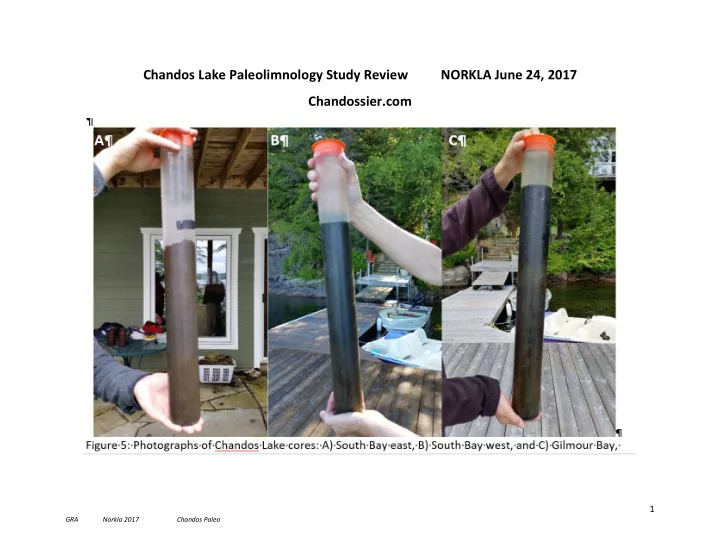

Chandos Lake Paleolimnology Study Review NORKLA June 24, 2017 Chandossier.com 1 GRA Norkla 2017 Chandos Paleo
Paleolimnology is the study of aquatic systems that uses the physical, chemical, and biological information preserved in sedimentary profiles to reconstruct past environmental conditions (Smol, 2008). We were looking for what changes might have occurred in the lake since before settlement to the present day by determining the diatoms species in the top slice and the bottom slice of each of the above cores. Each diatom species has specific ecological requirements, so by analyzing diatom fossil assemblages much can be learned about past water quality. Diatoms are a group of photosynthesizing algae, both planktonic and benthic. They have a siliceous cell wall called a frustule. As these algae die, their frustules collect in the sediment, and thereby provide a historical record of lake conditions. We also collected limnological data from the top and bottom waters. (Chemistry, Dissolved Oxygen, SpCond, Oxidation-Reduction Potential, Temperatures profile, Secchi depths) While research answers some questions, it usually leads to more questions and the need for more research. So is the case here. The diatom changes do indicate a move towards greater eutrophication, but without further analysis down the core, it is difficult to separate out the past anthropogenic influences from the recent global warming effects. Certainly, something was changing over the time span of the cores, as changes in colour were observed. I would say the lake has not changed substantially over time; however, it looks like climate change is going to influence all lakes in mid Ontario over the next 50 years. Gilmour Bay stood out from South Bay for the following reasons: i) The bottom waters are oxygen depleted shortly into the season ii) The phos and nitrogen are very high in the bottom waters compared to the top. These nutrients will get released at fall turnover and may cause spring algae blooms when all other conditions are right. iii) There were elevated Na and Cl concentrations in the bottom waters as compared to the top. iv) The elevated salt levels are suspected to be due to road salt. This may be interfering with the mixing during spring and fall turnovers, thereby impeding the re-oxygenation of the lower levels of the water column. This study provides a scientific benchmark of the lake status in 2014 for future comparison and research. See the full report at Chandossier.com 2 GRA Norkla 2017 Chandos Paleo
This graph shows the effects of global warming on Chandos Lake; the ice cover trend line shows a decrease of about 13 days over 31 years. 11 of those days due to a later freeze over. The breakup date has changed very little. 3 GRA Norkla 2017 Chandos Paleo
This graph shows a very long data set for Scugog Lake. It quite dramatically shows the recent effects of global warming. 4 GRA Norkla 2017 Chandos Paleo
Recommend
More recommend